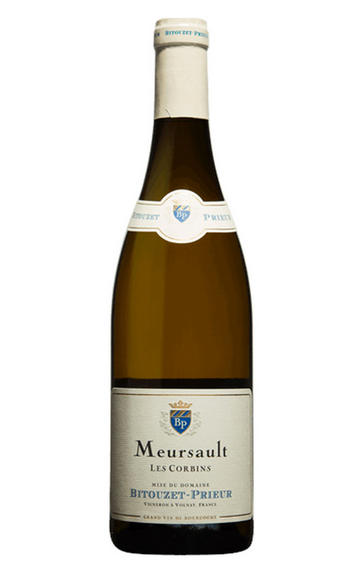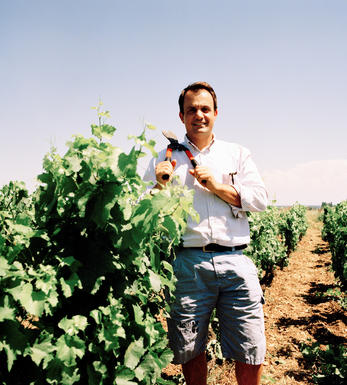
2017 Meursault, Les Corbins, Domaine Bitouzet-Prieur, Burgundy

About this WINE

Domaine Bitouzet-Prieur
Domaine Bitouzet-Prieur – along with current winemaker François – was born of the marriage of Vincent Bitouzet (of Volnay) and Ann Prieur (of Meursault), bringing together two distinguished Burgundian families.
The domaine has a red cellar next door to Lafarge (who are distant cousins) and a white cellar in Meursault, with reds making up approximately 60 percent of production.
The estate’s notable vineyard holdings include a selection of the finest Premier Cru sites in Volnay and Meursault. The whites are elegant and restrained, rather than being broad-shouldered, old-fashioned Meursault. The reds are de-stemmed, with new oak kept to a modest level.

Meursault
There are more top producers in Meursault than in any other commune of the Côte d’Or. Certainly it is the most famous and popular of the great white appellations. Its wines are typically rich and savoury with nutty, honeyed hints and buttery, vanilla spice from the oak.
Even though it is considerably larger than its southerly neighbours Chassagne and Puligny, Meursault contains no Grands Crus. Its three best Premiers Crus, however – Les Perrières, Les Genevrières and Les Charmes – produce some of the region’s greatest whites: they are full, round and powerful, and age very well. Les Perrières in particular can produce wines of Grand Cru quality, a fact that is often reflected in its price. Meursault has also been one of the driving forces of biodynamic viticulture in the region, as pioneered by Lafon and Leflaive.Many of the vineyards below Premier Cru, known as ‘village’ wines, are also well worth looking at. The growers vinify their different vineyard holdings separately, which rarely happens in Puligny or Chassagne. Such wines can be labelled with the ‘lieu-dit’ vineyard alongside (although in smaller type to) the Meursault name.
Premier Cru Meursault should be enjoyed from five to 15 years of age, although top examples can last even longer. Village wines, meanwhile, are normally at their best from three to 10 years.
Very occasionally, red Meursault is produced with some fine, firm results. The best red Pinot Noir terroir, Les Santenots, is afforded the courtesy title of Volnay Santenots, even though it is actually in Meursault.
- 305 hectares of village Meursault. The best vineyards include Clos de la Barre, Tesson, Chevalières, Rougeot, Narvaux
- 132 hectares of Premier Cru vineyards (17 in all). The finest vineyards include Les Perrières, Les Genevrières and Les Charmes
- Recommended producers: Comte Lafon, Arnaud Ente, Coche Dury, Guy Roulot, Jean-Philippe Fichet, Patrick Javillier, François Jobard, Michel Bouzereau
- Recommended restaurant: Le Chevreuil

Chardonnay
Chardonnay is often seen as the king of white wine grapes and one of the most widely planted in the world It is suited to a wide variety of soils, though it excels in soils with a high limestone content as found in Champagne, Chablis, and the Côte D`Or.
Burgundy is Chardonnay's spiritual home and the best White Burgundies are dry, rich, honeyed wines with marvellous poise, elegance and balance. They are unquestionably the finest dry white wines in the world. Chardonnay plays a crucial role in the Champagne blend, providing structure and finesse, and is the sole grape in Blanc de Blancs.
It is quantitatively important in California and Australia, is widely planted in Chile and South Africa, and is the second most widely planted grape in New Zealand. In warm climates Chardonnay has a tendency to develop very high sugar levels during the final stages of ripening and this can occur at the expense of acidity. Late picking is a common problem and can result in blowsy and flabby wines that lack structure and definition.
Recently in the New World, we have seen a move towards more elegant, better- balanced and less oak-driven Chardonnays, and this is to be welcomed.


Buying options
Add to wishlist
Description
At 1.5 hectares, this is the domaine’s largest holding of Chardonnay, from a site between the village and the Santenots vineyards. The nose offers some spicy vanilla oak (20 percent new) along with white stonefruit touches. The palate has a charming balance of broad stone-fruit and intense freshness which is driven by a persistent acidity running from start to finish. Elegant for a low-slope Meursault. Drink 2021-2027.
François is keen to highlight the importance of the solidarity shown by the Côte’s vignerons at the end of April, when everyone came together to burn dampened bales and create cloud cover to ward off the frost. Without such action this could well have been another catastrophic yield. Having avoided this threat, the rest of the season was fairly straightforward with careful vineyard management and harvest began on the 30th August. He feels the whites are a mix of 2015 and 2014, while the reds are pretty and will drink well from an early age.
wine at a glance
Delivery and quality guarantee